iPhone 12 vs. iPhone 11: Which should you buy?
Should you save $200 and go with last year’s iPhone?
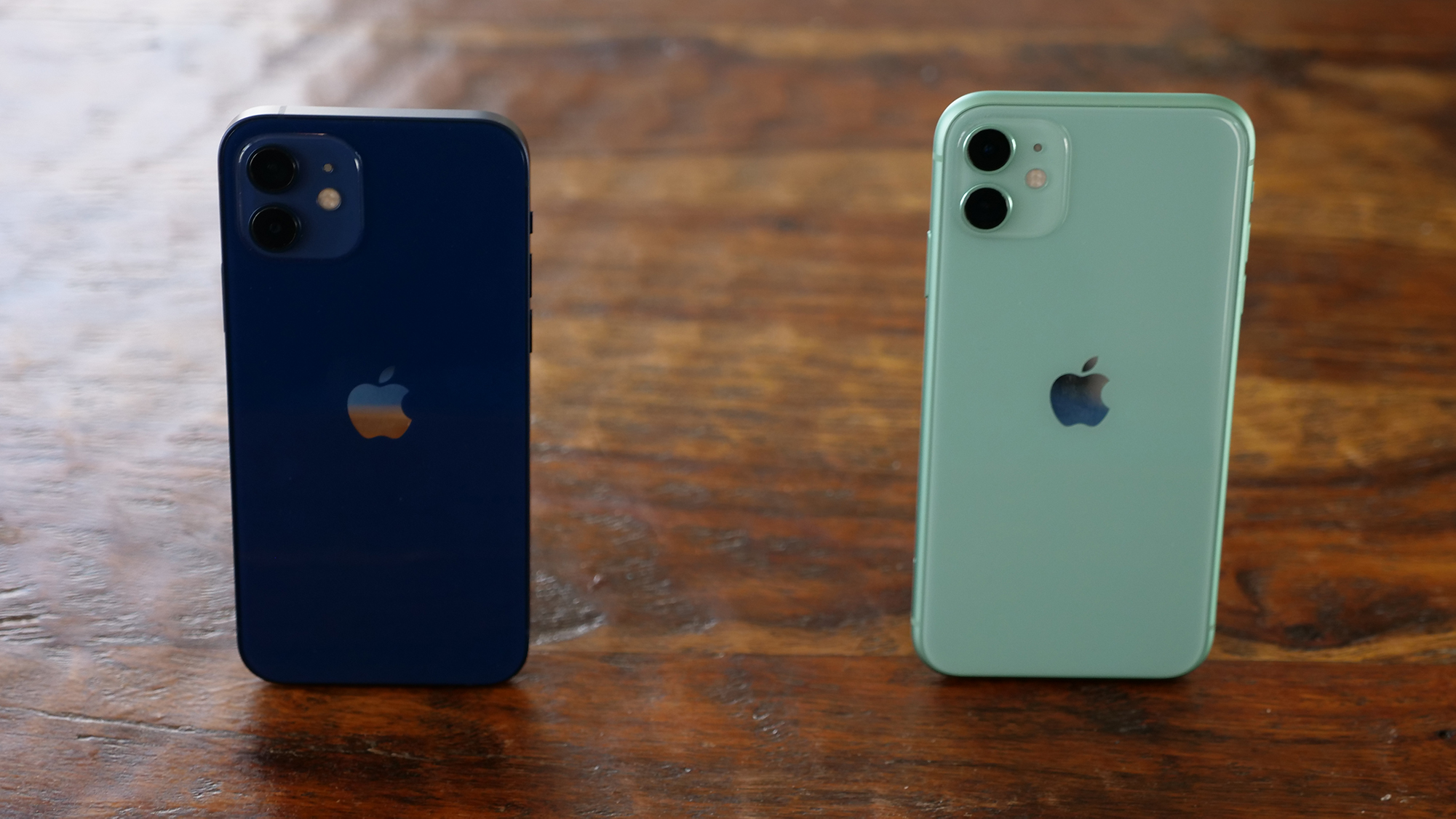
The iPhone 11 was our top recommendation as the best smartphones going into the release of the iPhone 12. With both now available, we wanted to take a careful look at what buyers are getting by opting for Apple’s latest or going with a last-gen device.
You are certainly going to be paying up for the privilege of getting the redesigned iPhone 12 as it starts at $100 more than the iPhone 11, which also saw a $100 price drop to $599 following the launch of the iPhone 12.
Despite some outward differences, there are a lot of similarities between the hardware in the iPhone 12 and the iPhone 11. The new OLED display and that powerful A14 Bionic processor are impressive for the iPhone 12, but as you’ll see, it’s not a clean sweep for the newer iPhone.
Here’s our breakdown of the iPhone 12 versus the iPhone 11 across six different categories to help you decide which is right for you.
- iPhone 12 review
- iPhone 12 Pro review
- Best smartphones in 2020
The most conspicuous dissimilarities between the iPhone 12 and the iPhone 12 Pro are found within their cameras. Both smartphones have 12MP front-facing, wide and ultra-wide cameras, but the iPhone 12 Pro adds a telephoto lens and LiDAR scanner. We’ll dive into how these additional features enhance your smartphone experience.
After testing the iPhone 12 and iPhone 12 Pro in our labs, we’ve also noticed some differences between the two devices when it comes to screen brightness, battery life, overall performance and more. Stick around to see how these high-end smartphone contenders fared in our face-off ring.
| Row 0 - Cell 0 | iPhone 12 | iPhone 11 |
| Display (refresh rate) | 60Hz, 6.1-inch, OLED, Super Retina XDR, 2532 x 1170 | 60Hz, 6.1-inch, LCD, Liquid Retina HD, 1792 x 828 |
| CPU | Apple A14 Bionic | Apple A13 Bionic |
| RAM | 4GB | 4GB |
| Storage | Starts at 64GB | Starts at 64GB |
| MicroSD slot | No | No |
| Rear cameras | Two 12MP lenses (wide, ultra wide) | Two 12MP lenses (wide, ultra wide) |
| Front camera | 12MP, f/2.2 aperture, TrueDepth | 12MP, f/2.2 aperture, TrueDepth |
| Battery size | 2,815 mAh | 3,110 mAh |
| Water resistance | Yes, IP68 | Yes, IP68 |
| Colors | Blue, black, white, red and green | Black, green, yellow, purple, white, Product Red |
| Dimensions | 5.8 x 2.8 x 0.3 inches | 5.94 x 2.98 x 0.33 inches |
| Weight | 5.8 ounces | 6.84 ounces |
iPhone 12 vs. iPhone 11: price and value
The iPhone 12 starts at $799 for a 64GB model with 4GB of RAM. You can double your storage to 128GB for another $50, or for $949, you can have the maxed-out 256GB model we reviewed.
Sign up to receive The Snapshot, a free special dispatch from Laptop Mag, in your inbox.
The iPhone 11 is now available starting at $599 for the 64GB model with 4GB of RAM. Upgraded storage still follows the same pattern with the 128GB model going for $649 and the top-end 256GB option at $749.
Follow along the rest of the way to find out if the differences are worth the cost to you, but at $200 less than the iPhone 12, the iPhone 11 definitely takes this round.
Winner: iPhone 11
iPhone 12 vs. iPhone 11: design
If you read my iPhone 12 review or our iPhone 12 Pro review, you’ve already heard us wax poetic about the redesign. For me, it’s an excellent reimagining of the popular design that originated with the iPhone 4, and it makes the iPhone stand out again with a unique yet functional design.
The iPhone 12 is more durable than ever with its ceramic shield display offering four times greater protection against drops. And its enhanced IP68 resistance against dust and water now enables the iPhone 12 to survive at greater depths for greater durations. In my experience, the squared-off design is still comfortable to hold and my colleague who reviewed the iPhone 12 Pro agreed.
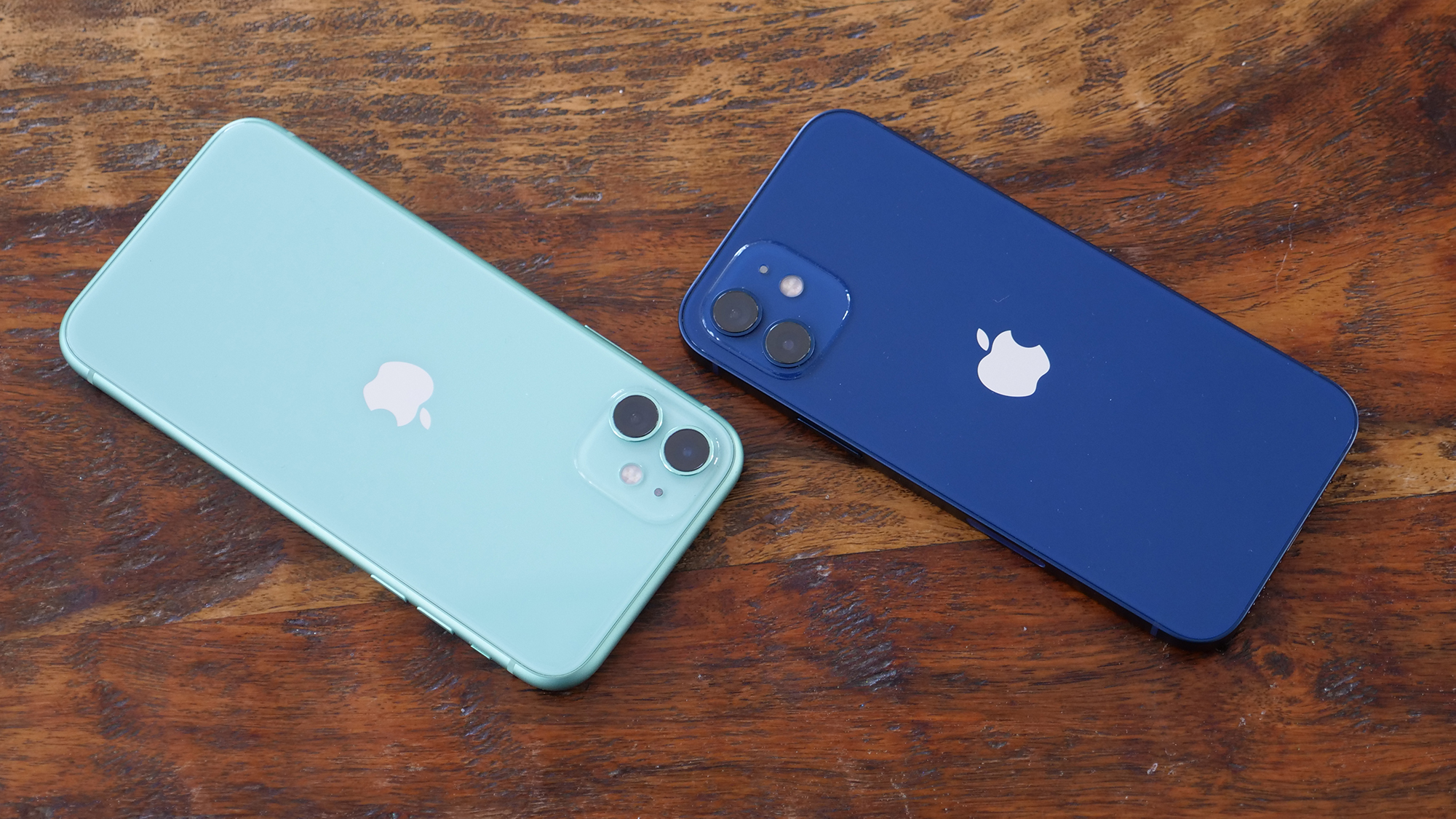
Some of this is attributable to the iPhone 12 being smaller in every dimension than the iPhone 11. At 5.8 x 2.8 x 0.3 inches, the entirety of the iPhone 12 fits inside the same space as the screen of the 5.9 x 3 x 0.33-inch iPhone 11. The iPhone 12 is also over a full ounce lighter than the iPhone 11 at 5.8 ounces versus 6.8 ounces.
Now, design is largely subjective, but I’d argue that there are some objective advantages like the size and durability here. If you like the rounded edge look of the iPhone 11 and its predecessors, that isn't an earth-shattering advantage to miss out on. But I mean c’mon, the flat-edged iPhone 12 can be its own stand again!
Winner: iPhone 12
iPhone 12 vs. iPhone 11: display
With the exception of design, this is the most outwardly visible change to the iPhone 12 from the iPhone 11. While both smartphones feature a 6.1-inch display, the iPhone 12 now joins the Pro models in using a Super Retina XDR OLED with a 2532 x 1170-pixel display as compared to the 1792 x 828-resolution of the iPhone 11’s Liquid Retina HD LCD. Apple also reduced the bezels on the iPhone 12 display though the notch remains unchanged.
So specs aside, does this actually make a visible difference? It absolutely does. When I loaded the HDR showcase that is Our Planet and placed the iPhones side-by-side, it was immediately apparent that the iPhone 12 is the superior display. It delivers not only more colorful images, but to my eye, a brighter picture, something that is at odds with our testing (as you’ll see later). The resolution difference is less noticeable to me; I was able to pick out minute details on both devices, but the added contrast and deeper black levels of the iPhone 12 are unmistakable.
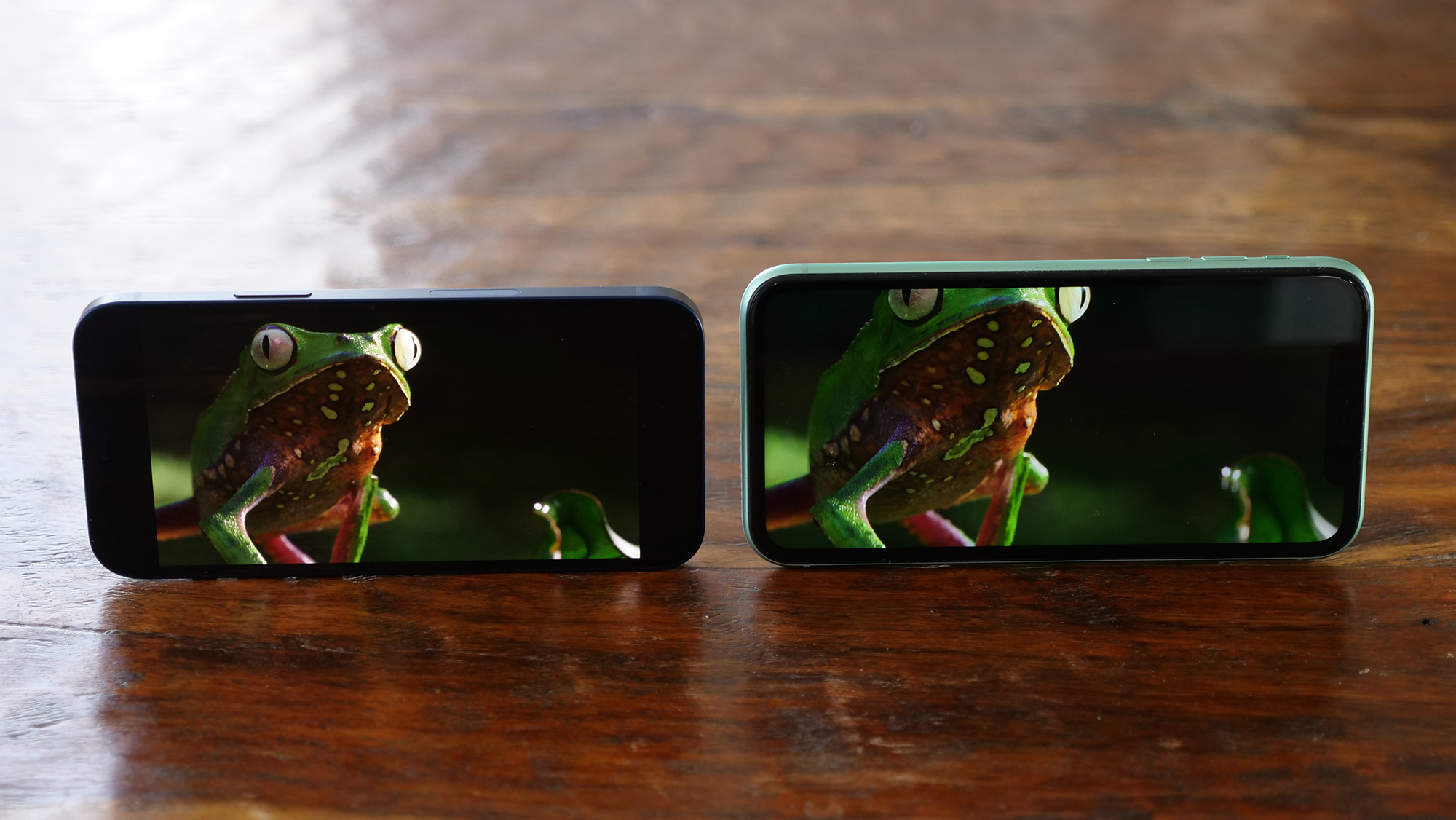
It’s worth noting that the iPhone 12 did not make the jump to a 120Hz display, a long-rumored feature that we now expect to see next year. Virtually every flagship Android smartphone comes with a 90Hz or 120Hz refresh rate this year and even the iPhone 12 suffers by comparison next to these displays. That said, those considering a move from the iPhone 11 to the iPhone 12 should consider waiting it out for that upgrade with the iPhone 13.
Taking a look at our colorimeter results, the iPhone 12 covers 114.5% of the sRGB color spectrum, which is virtually identical to the 113% that the iPhone 11 managed. Brightness tipped in favor of the iPhone 11 in our testing with 652 nits of brightness compared to 570 nits for the iPhone 12. Again, I did not find that to be the case in my real-world testing as both displays are sufficiently bright.
The iPhone 12 managed a Delta-E score of 0.29 (lower is better) when tested for accuracy, which is a significant step down from the excellent 0.22 that the iPhone 11 achieved.
Winner: iPhone 12
iPhone 12 vs. iPhone 11: performance
The iPhone 11 and its A13 Bionic chip are still among the most powerful smartphones on the market today, but the iPhone 12 with its A14 Bionic is superior. Both smartphones feature 4GB of RAM, which pales in comparison to many Android devices, but this has never been an issue for Apple and iOS.
Honestly, both iPhones give you more power than you could need in a smartphone; there’s no number of Google Chrome tabs, apps, picture-in-picture video or games that I could throw at either smartphone to cause them to slow down. As I’ll demonstrate with the benchmarks below, the iPhone 12 is faster, but that alone is certainly no reason to buy it over the iPhone 11.
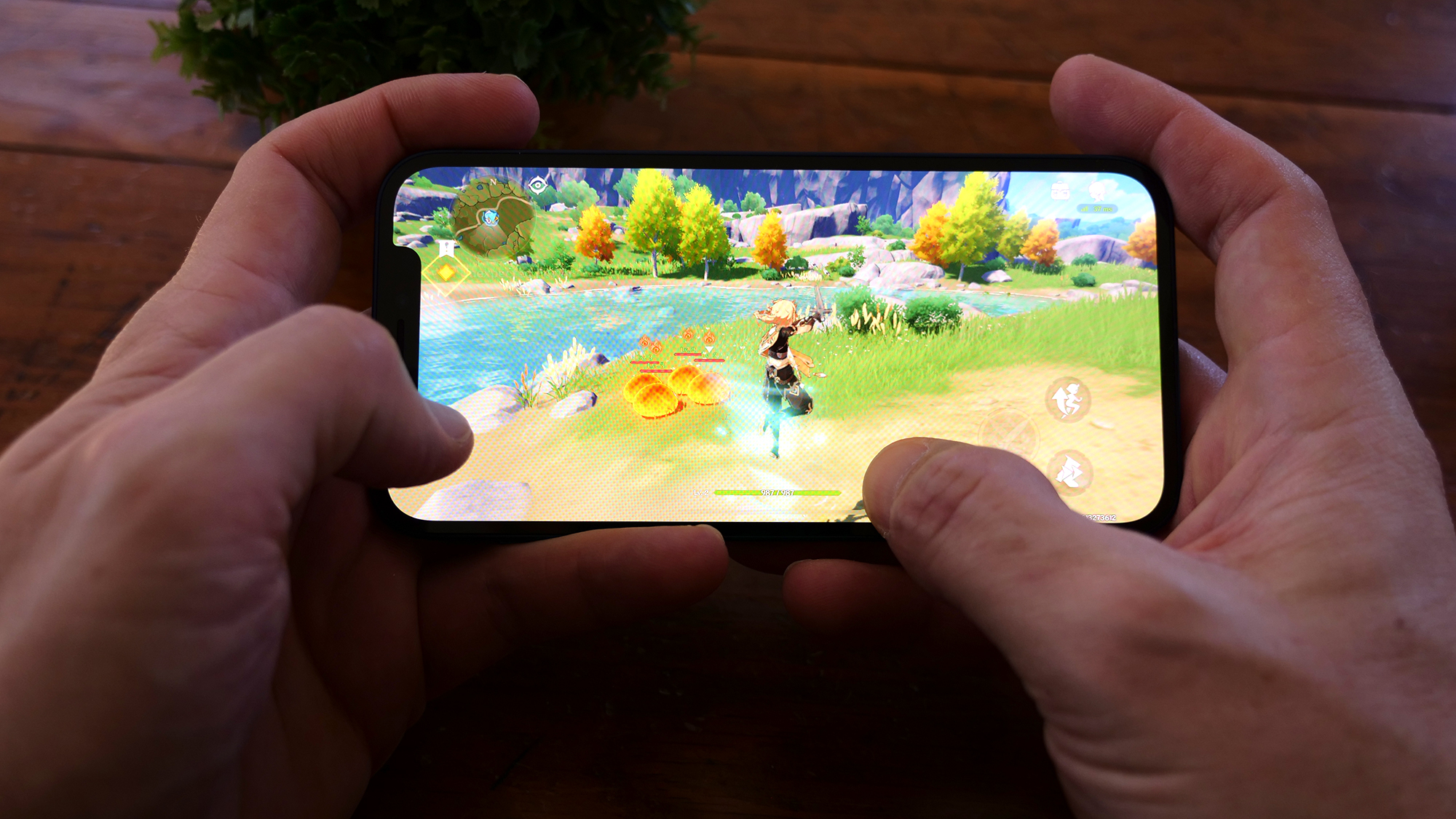
On the Geekbench 5.0 overall performance test, the iPhone 12 achieved a score of 3,589, which is one of the top scores ever produced by a smartphone. The iPhone 11 comes in behind with a very respectable 3,251, which is still good enough to top virtually every Android smartphone.
In our Adobe Premiere Rush video editing test, the iPhone 12 took 26.5 seconds to finish rendering and exporting a 4K video to 1080p. The same task took the iPhone 11 a total of 45 seconds, which is once again faster than any Android smartphone.
On the GFXBench 5.0 benchmark, which tests graphics performance, the iPhone 12 managed 2,186 frames (34 frames per second) on Aztec Ruins Metal in High Tier Off-Screen. This is one area where the iPhone 11 does not manage to hold up with 1,481 frames (23 fps), so for the dedicated mobile gamers, these scores might be a real consideration for you.
Winner: iPhone 12
iPhone 12 vs. iPhone 11: battery life and charging
The iPhone 12 has caused quite a stir in this area due to reports of poor battery life and Apple’s divisive removal of the power adapter from the box. Now new iPhone 11 packaging removes it as well, so depending on where you purchase it from, you may not be getting that advantage. It’s frustrating for such an expensive smartphone and will require you to pick up a USB-C power adapter to make use of the included USB-to-Lighting cable if you don’t already have one. There is truth to Apple’s environmental message there, it’s just a bit buried by the clear profit motive that’s also guiding the decision.
Moving on to the actual battery life, the iPhone 11 is hands down the winner in this category. In our Laptop Mag battery test (involves continuous web surfing at 150 nits of brightness), the iPhone 11 made it 11 hours and 16 minutes. By comparison, on its default settings, the iPhone 12 only lasted 8 hours and 24 minutes. The main culprit here is 5G, which the iPhone 11 lacks; if you disable 5G on the iPhone 12 you will see a significant boost, up to 10 hours and 23 minutes in our testing on 4G. However, that still tips quite a bit in favor of the iPhone 11 for heavy app users.

In the iPhone 12’s favor on the charging front is the addition of MagSafe, which is a circular magnet located in the back of the iPhone 12 and an associated MagSafe charger, available for $39 from Apple. This still, fortunately, uses Qi wireless charging, so any existing wireless chargers you have will still work, but the magnets are enabling a lot of interesting new accessories.
While MagSafe is cool, I’m not letting it trump the superior battery life of the iPhone 11, so the older phone gets the win here.
Winner: iPhone 11
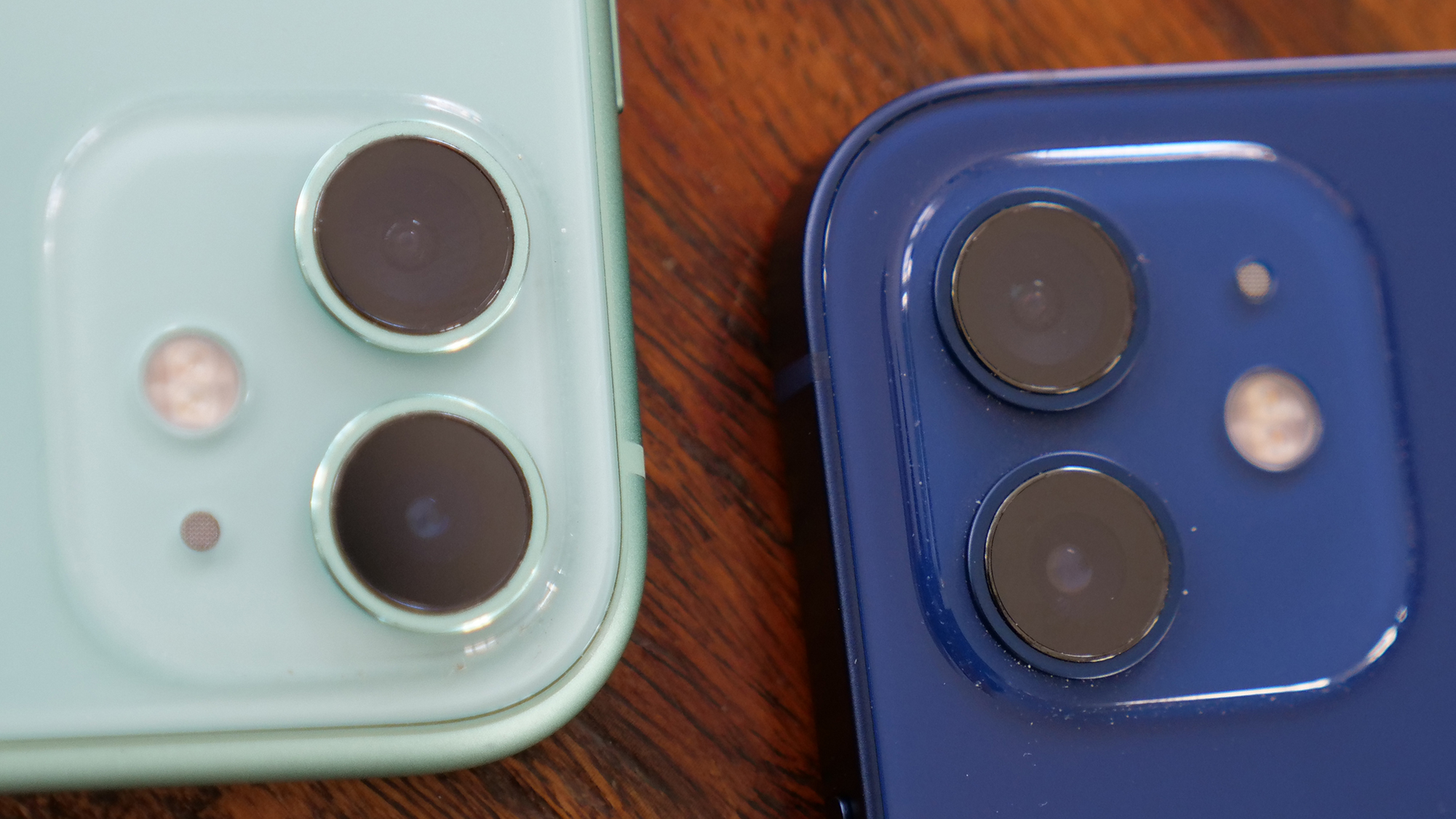
iPhone 12 vs. iPhone 11: cameras
The actual camera hardware on the iPhone 12 and the iPhone 11 seems to be identical. Both feature three 12-megapixel cameras: a primary wide-angle with an f/1.6 aperture, an ultra-wide lens with an f/2.4 aperture and the front-facing TrueDepth camera with an f/2.2 aperture.
As you would probably expect, the standard photos from both look extremely similar. Here’s a quick sampling of photos captured on the iPhone 12.



And here are the same photos captured with the iPhone 11. The differences are negligible.



With that said, there are some differences based on the A14 Bionic that powers the iPhone 12. Apple’s new chipset dramatically boosted the computational photography capabilities of the iPhone 12 and made some features like Night Mode work much better (as you can see below). And I expect to see some of these enhancements only increase with future software updates to the iPhone 12.

iPhone 12 Night Mode Sample

iPhone 11 Night Mode Sample
Users who want the best camera experience on an iPhone need to look at the Pro models, but despite the identical hardware, I give the camera edge to the iPhone 12 here.
Winner: iPhone 12
Overall winner: iPhone 12
While the iPhone 12 may have dominated most of the categories, I want to make it clear that I don’t think it walks away with this face-off.
My personal affinity for the design aside, the new chassis is not game-changing from a functionality standpoint. The display and performance are better on the iPhone 12, but this is only really noticeable when viewing them side-by-side. In a vacuum, the iPhone 11 screen looks great and it is more than capable of any task you’ll give it.

So what are the real difference makers?
For the iPhone 11, it’s the battery life and the value. The iPhone 11 easily outlasts the iPhone 12 and, if you are someone that really hammers the battery on your phone, it’s enough of a difference to be a consideration. Value is easy. I’d recommend jumping to the 128GB storage option for both which puts you at $649 for the iPhone 11 and $849 for the iPhone 12.
The iPhone 12, on the other hand, is really future-proofing you. Support for 5G, battery slayer though it may be, is going to become relevant over the next couple of years. The A14 Bionic may be overkill now, but in 2 to 3 years you will no doubt appreciate the extra processing power and a boost to the cameras thanks to machine learning advancements.
If you can afford the extra $200, you won’t regret the iPhone 12 purchase, but if you can’t. rest assured that while you may be settling for the iPhone 11, you are opting for what is still one of the best smartphones available today.
Sean Riley has been covering tech professionally for over a decade now. Most of that time was as a freelancer covering varied topics including phones, wearables, tablets, smart home devices, laptops, AR, VR, mobile payments, fintech, and more. Sean is the resident mobile expert at Laptop Mag, specializing in phones and wearables, you'll find plenty of news, reviews, how-to, and opinion pieces on these subjects from him here. But Laptop Mag has also proven a perfect fit for that broad range of interests with reviews and news on the latest laptops, VR games, and computer accessories along with coverage on everything from NFTs to cybersecurity and more.

